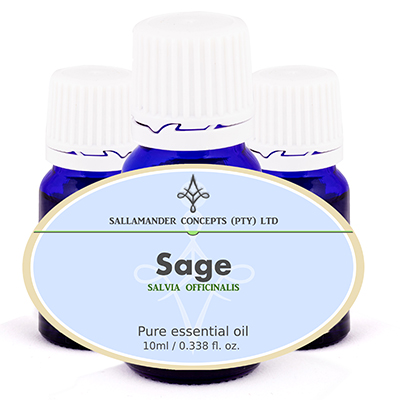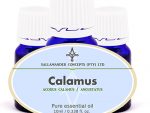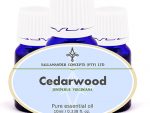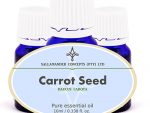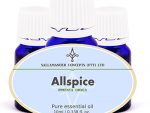Information on Sage essential oil
Sage essential oil is extracted from Salvia officinalis of the Labiatae family and is also known as garden, true and Dalmatian sage.
Sage essential oil is toxic and should not be ingested.
Even though high amounts of Sage Essential Oil can cause problems, it can be used in Aromatherapy with great effect on a variety of problems, as long as low percentages are used.
It is great for relieving grief and quickening the senses, while stimulating the lymphatic system and helping with female problems, such as sterility and menopausal problems. On the skin it not only helps healing but also to reduce pore size.
Oil Properties
Sage Essential Oil has a sharp, herbal smell, and is watery in viscosity.
Origin
It is an evergreen perennial herb that can grow up to about 60cm ( 2 feet) high with a woody base, soft gray-green oval leaves and a mass of blue or violet flowers.
The Chinese believed that it cured sterility, while the Romans believed it cured just about everything.
The name is derived from the Latin word ‘salvare’ which means ‘heal’ or ‘save’ and during the Middle Ages it was a popular ingredient of many nerve tonics and the herb was also used to clean gums.
Extraction
Sage Essential Oil is extracted from the dried leaves by steam distillation.
Chemical composition
Some of the main chemical components of Dalmatian sage oil are Camphor, α-Thujone, Borneol, 1,8-Cineole, β-Thujone, β-Caryophyllene
Precautions
Sage is a powerful oil and should not be ingested. It is known to be a neurotoxin. Dalmatian sage should not be used when pregnant or breastfeeding. Dalmatian sage essential oil should not be used on children under the age of 7 years.
As with most essential oils, this essential oil should be kept safely in a dark and cool place and should be stored in an airtight glass bottle (Preferably in the fridge at a temperature of around 4° Celsius / 39° Fahrenheit).
Please read our page with heading: Safety with Essential Oils before using this oil.
We recommend the following book as an excellent resource regarding safety:
Essential Oil Safety: A Guide for Health Care Professionals by Robert Tisserand & Rodney Young (#ad)
Therapeutic properties
The therapeutic properties of Sage Essential Oil are anti-inflammatory, antibacterial, antiseptic, antispasmodic, astringent, digestive, diuretic, emmenagogue, febrifuge, hypertensive, laxative, stomachic and tonic.
For our glossary and explanation of these therapeutic terms, please click here
Uses
Even though Sage Essential Oil can be toxic in large dosages, it still offers some very good therapeutic properties which should be balanced against the side effects of this oil.
It is effective to stimulate the digestion and especially a bad appetite.
Due to its hormonal regulatory effect, it is most useful for menstrual problems, as well as the pain associated with rheumatism.
It helps to deal with grief and depression and quickens the senses and has been used to combat female sterility, as well as menopausal problems.
It has a tonic effect on the urinary tract as well as the liver and kidneys.
Sage oil also stimulates the lymphatic system and thereby boost glandular function while it also has value to treat dermatitis, atonic wounds, sores, ulcers, as well as insect bites and reducing large pores.
On the muscular system it can be used to ease stiff muscles and particularly fibrositis and torticollis (stiff neck) and eases trembling and palsy.
If the toxic effects of sage oil bothers you, you could consider clary sage oil as it has similar properties as sage oil, but does not have the side effects.
Burners and vaporizers
Used in vapor therapy by means of a burner or vaporizer, this oil can be used to calm the nerves and help with grief and depression, while quickening the senses and aiding memory.
Blended in Massage Oil or in the Bath
When blended as a very small part of a massage oil, or used very sparingly in the bath, it can help with female sterility as well as menopausal problems while boosting the urinary tract, liver and kidneys, lymphatic system, while relaxing the muscles and sorting out fibrositis as well as torticollis – a stiff neck – as well as trembling and palsy.
Blended in a Cream
Although the risk of too much sage oil must be carefully weighed against the positive effect it can have, it can be used with success to reduce pore size, healing of sores, atonic wounds, psoriasis, dermatitis as well as ulcers.
Suggested Dilution Rates
On the skin
Adult:
Face: 0.25% to 0.4%
Body: 0.25% to 0.4%
Bath: 0.25% to 0.4%
3 to 24 months:
Do NOT use topically. Avoid use.
2 to 6 years:
Do NOT use topically. Avoid use.
7 to 15 years
Face: Avoid
Body: Maximum of 0.1%
Bath: Maximum of 0.1%
Pregnancy
Do NOT use topically. Avoid use.
- When in doubt consult your doctor / medical professional before use.
- Most professionals and/or Aromatherapists will always err on the side of safety when giving advice regarding the use of essential oils and oleo resins during pregnancy.
- Quite a number of Aromatherapists advise that you should avoid all essential oils completely while pregnant, specifically during the first trimester. This is a very safe approach but is necessary in this case.
Diffusers and Vaporisers
4 to 8 drops
General:
- When using for the first time – Always use the lowest dilution rate and build up slowly to the maximum. Stop using all essential oils on the skin if irritation or allergy occurs.
- Any advice or instruction received from a medical professional ALWAYS supersedes recommendations or advice found on this website. When in doubt consult your doctor / medical professional.
Blends
Although essential oils blend well with one another, sage oil blends particularly well with Bergamot, Lavender, Lemon and Rosemary.

